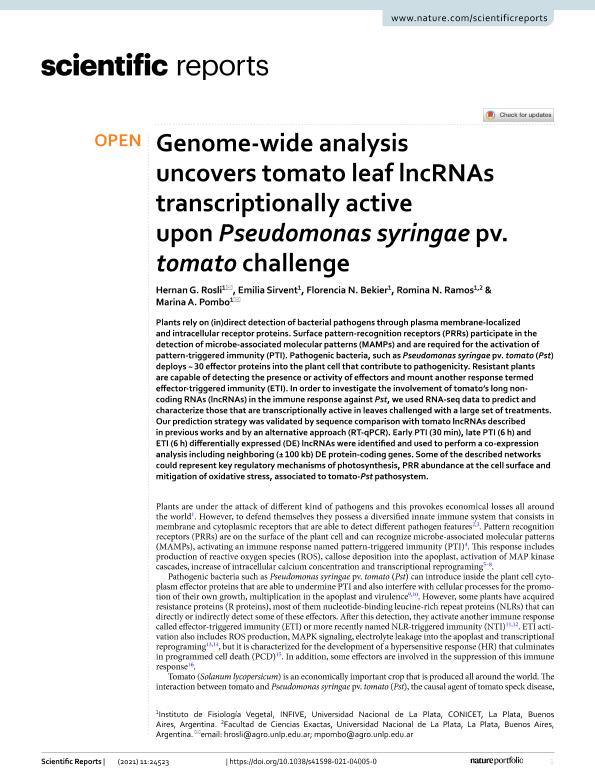Artículo
Genome-wide analysis uncovers tomato leaf lncRNAs transcriptionally active upon Pseudomonas syringae pv. tomato challenge
Rosli, Hernan Guillermo ; Sirvent, Emilia; Bekier, Florencia Nicole
; Sirvent, Emilia; Bekier, Florencia Nicole ; Ramos, Romina Nahir
; Ramos, Romina Nahir ; Pombo, Marina Alejandra
; Pombo, Marina Alejandra
 ; Sirvent, Emilia; Bekier, Florencia Nicole
; Sirvent, Emilia; Bekier, Florencia Nicole ; Ramos, Romina Nahir
; Ramos, Romina Nahir ; Pombo, Marina Alejandra
; Pombo, Marina Alejandra
Fecha de publicación:
12/2021
Editorial:
Nature Research
Revista:
Scientific Reports
e-ISSN:
2045-2322
Idioma:
Inglés
Tipo de recurso:
Artículo publicado
Clasificación temática:
Resumen
Plants rely on (in)direct detection of bacterial pathogens through plasma membrane-localized and intracellular receptor proteins. Surface pattern-recognition receptors (PRRs) participate in the detection of microbe-associated molecular patterns (MAMPs) and are required for the activation of pattern-triggered immunity (PTI). Pathogenic bacteria, such as Pseudomonas syringae pv. tomato (Pst) deploys ~ 30 effector proteins into the plant cell that contribute to pathogenicity. Resistant plants are capable of detecting the presence or activity of effectors and mount another response termed effector-triggered immunity (ETI). In order to investigate the involvement of tomato’s long non-coding RNAs (lncRNAs) in the immune response against Pst, we used RNA-seq data to predict and characterize those that are transcriptionally active in leaves challenged with a large set of treatments. Our prediction strategy was validated by sequence comparison with tomato lncRNAs described in previous works and by an alternative approach (RT-qPCR). Early PTI (30 min), late PTI (6 h) and ETI (6 h) differentially expressed (DE) lncRNAs were identified and used to perform a co-expression analysis including neighboring (± 100 kb) DE protein-coding genes. Some of the described networks could represent key regulatory mechanisms of photosynthesis, PRR abundance at the cell surface and mitigation of oxidative stress, associated to tomato-Pst pathosystem.
Palabras clave:
TOMATO
,
PSEUDOMONAS SYRINGAE
,
PLANT-PATHOLOGY
,
PHYTOPATOLOGY
Archivos asociados
Licencia
Identificadores
Colecciones
Articulos (IABIMO)
Articulos de INSTITUTO DE AGROBIOTECNOLOGIA Y BIOLOGIA MOLECULAR
Articulos de INSTITUTO DE AGROBIOTECNOLOGIA Y BIOLOGIA MOLECULAR
Citación
Rosli, Hernan Guillermo; Sirvent, Emilia; Bekier, Florencia Nicole; Ramos, Romina Nahir; Pombo, Marina Alejandra; Genome-wide analysis uncovers tomato leaf lncRNAs transcriptionally active upon Pseudomonas syringae pv. tomato challenge; Nature Research; Scientific Reports; 11; 1; 12-2021; 1-13
Compartir
Altmétricas



